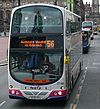Related Research Articles

The Glasgow Subway is an underground light metro system in Glasgow, Scotland. Opened on 14 December 1896, it is the third-oldest underground rail transit system in Europe after the London Underground and the Budapest Metro. It is also one of the very few railways in the world with a track running gauge of 4 ft. Originally a cable railway, the subway was later electrified, but the double-track circular line was never expanded. The line was originally known as the Glasgow District Subway, and was thus the first mass transit system to be known as a "subway"; it was later renamed Glasgow Subway Railway. In 1936 it was renamed the Glasgow Underground. Despite this rebranding, many Glaswegians continued to refer to the network as "the Subway". In 2003, the name "Subway" was officially readopted by its operator, the Strathclyde Partnership for Transport (SPT).

Ibrox Stadium is a football stadium on the south side of the River Clyde in the Ibrox area of Glasgow, Scotland. The home of Scottish Premiership team Rangers Football Club, Ibrox is the third largest football stadium in Scotland, with an all-seated capacity of 50,987. The stadium was designed by renowned football stadium architect Archibald Leitch, with renovations to the stadium between 1978 and 1981, as well as 1990 and 1991, being designed by The Miller Partnership and Gareth Hutchison respectively.

The North Clyde Line is a suburban railway in West Central Scotland. The route is operated by ScotRail. As a result of the incorporation of the Airdrie–Bathgate rail link and the Edinburgh–Bathgate line, this route has become the fourth rail link between Glasgow and Edinburgh.

Bellahouston is a district in the southwest of Glasgow. It is bordered by Dumbreck, Ibrox, Pollokshields, Craigton.
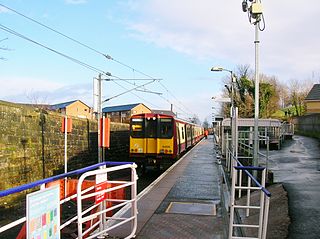
The Paisley Canal line is a branch railway line in Scotland running between Glasgow and Paisley. The line currently terminates at Paisley Canal railway station, although it previously continued through Paisley West station, near Ferguslie, to Elderslie junction where it met and crossed under the main Glasgow and South Western Railway line running from Paisley Gilmour Street station to Johnstone, and beyond. After Elderslie, the line terminated at North Johnstone, however another junction allowed services from the Paisley Canal line to continue onto the Bridge of Weir Railway and Greenock and Ayrshire Railway to the latter's terminus at Greenock Princes Pier.
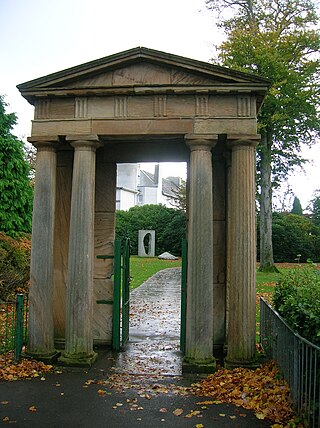
Bellahouston Park is a public park in the Bellahouston district on the South Side of Glasgow, Scotland, between the areas of Craigton, Dumbreck, Ibrox and Mosspark covering an area of 71 hectares. The main part of Bellahouston Park was acquired by Glasgow Corporation in 1895 for the sum of £50,000, and opened to the public in 1896. Three years later, the city's second municipal golf course was established at Bellahouston, following the success of the course at Alexandra Park. The park was extended in 1901 by the addition of a part of Dumbreck Lands purchased for £2,824 from Sir John Stirling-Maxwell. A further addition was made in 1903, at a cost of £40,222, by including the lands of Ibroxhill, from which commanding views of the city are available.

Carmyle railway station is located in the Carmyle area of Glasgow. It is on the Whifflet Line, 5.5 miles (8.9 km) east of Glasgow Central railway station. Services are provided by ScotRail.

Partick is combined National Rail and Glasgow Subway station in the Partick area of Glasgow, Scotland. Along with the adjacent bus station, it forms one of the main transport hubs in Glasgow. As of 2022, it was the fifth-busiest station in Scotland, but was overtaken in 2023. The station is served by Glasgow Subway and ScotRail services and was one of the first to receive bilingual English and Gaelic signs, due to the significant Gaelic-speaking population in the surrounding Partick area.

Dumbreck railway station is a railway station in Dumbreck, a district of Glasgow, Scotland. The station is managed by ScotRail and lies on the Paisley Canal Line, 1+3⁄4 miles west of Glasgow Central, close to the M77 motorway. It is accessed from the Nithsdale Road at the bridge over the railway. Dumbreck railway station is also the closest station for the Bellahouston Park.
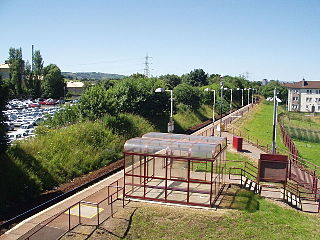
Hawkhead railway station is a railway station in the Seedhill area of Paisley, Renfrewshire, Scotland. The station is managed by ScotRail and lies on the Paisley Canal Line, 6½ miles (10 km) west of Glasgow Central.

Partickhill railway station was a railway station serving the Partick area of Glasgow. The station was opened by the North British Railway Company in 1874 on the north side of Dumbarton Road. At some periods during its existence it was described as Partick for Govan in some timetables.
Merkland Street station was one of the original 15 stations on the Glasgow Subway. It is the only ghost station on the system. The station opened in 1896. It was located 25 metres (27 yd) to the south-west of its replacement, Partick station and about 300 metres (330 yd) to the south of Partickhill railway station. It closed permanently in 1977 when the rest of the network was closed for modernisation. The modernisation had been announced in 1974 by the subway's then operators, the Greater Glasgow Passenger Transport Executive (GGPTE). Although converted to electric traction in 1935, the system's infrastructure and rolling stock was virtually unchanged from its opening in 1896, and improvement to the subway was seen by the GGPTE as an essential part of plans to eliminate transport bottlenecks in the city. As part of the process, which began in 1977, all 15 stations were to be rebuilt. However it was planned to link the subway to the national rail network's newly reopened Argyle Line at Partick via an interchange station. This meant permanently closing Merkland Street and opening a new station a short distance away.
The Maidens and Dunure Light Railway was a railway in Ayrshire, Scotland built to open up coastal communities by connecting them to the main line railway network.
Ibrox, from the Scottish Gaelic term for badger den, may refer to:
Govan railway station was a railway station in Govan, a district of Glasgow, Scotland. The station was originally part of an extension to the Glasgow and Paisley Joint Railway.

Bellahouston railway station was a railway station serving the Bellahouston area of Glasgow, Scotland. The station was originally part of the G&SWR Paisley Canal Branch.
Cessnock is an area in the city of Glasgow, Scotland. It is situated south of the River Clyde and was part of the former Burgh of Govan. Cessnock's main street is Paisley Road West, which runs west in the direction of Paisley and east through Kinning Park to Paisley Toll.
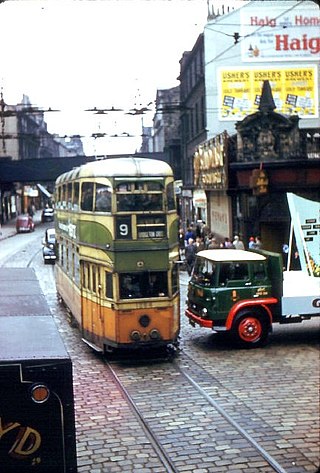
Glasgow Corporation Tramways were formerly one of the largest urban tramway systems in Europe. Over 1000 municipally-owned trams served the city of Glasgow, Scotland, with over 100 route miles by 1922. The system closed in 1962 and was the last city tramway in Great Britain.
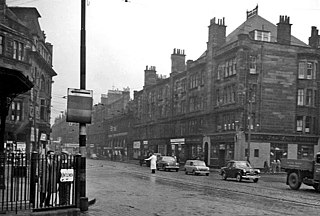
Bridgeton Central railway station was located in Glasgow, Scotland and served the Bridgeton area of that city. On the Glasgow City and District Railway it was located on the modern North Clyde line on a branch from High Street and acted as a terminus for services from the north west of the city.
The Bouncy or The Bouncy Bouncy is a sports celebration which involves jumping up and down on the spot while chanting the word "bouncy" or "Let's all do the bouncy" over and over again. It is mainly done by fans of Scottish association football club Rangers, Australian club Brisbane Roar, Swazi team Eleven Men in Flight F.C. and the Northern Ireland national football team. The Bouncy was first performed in 1984 as a terrace song at Rangers' home ground Ibrox Stadium. In 1990, the then Rangers head of security, Alistair Hood jokingly suggested that Ibrox Stadium should have seatbelts installed to stop fans doing The Bouncy. The action was brought to the attention of a wider audience when Rangers fans were seen doing it in the City of Manchester Stadium in the 2008 UEFA Cup Final against Zenit St Petersburg. In recent times, the bouncy has become commonplace with fans of League of Ireland Side Limerick FC.
References
- 1 2 Butt, page 32
- 1 2 Butt, page 126
- ↑ "RST Raise Ibrox Rail Link Issue". www.rangerssupporterstrust.co.uk. Rangers Supporters' Trust. 19 December 2007. Retrieved 2 September 2012.[ permanent dead link ]
- Sources
- Butt, R.V.J. (1995). The Directory of Railway Stations, Patrick Stephens Ltd, Sparkford. ISBN 1-85260-508-1.
| Preceding station | Historical railways | Following station | ||
|---|---|---|---|---|
| Govan Line and Station closed | Caledonian and Glasgow & South Western Railways Glasgow and Paisley Joint Railway (Govan Branch) | Pollokshields Line open; Station closed | ||
| Cardonald Line and Station open | Caledonian and Glasgow & South Western Railways Glasgow and Paisley Joint Railway | |||
